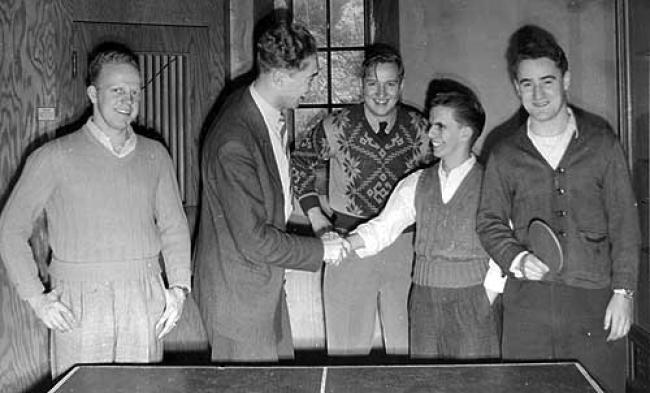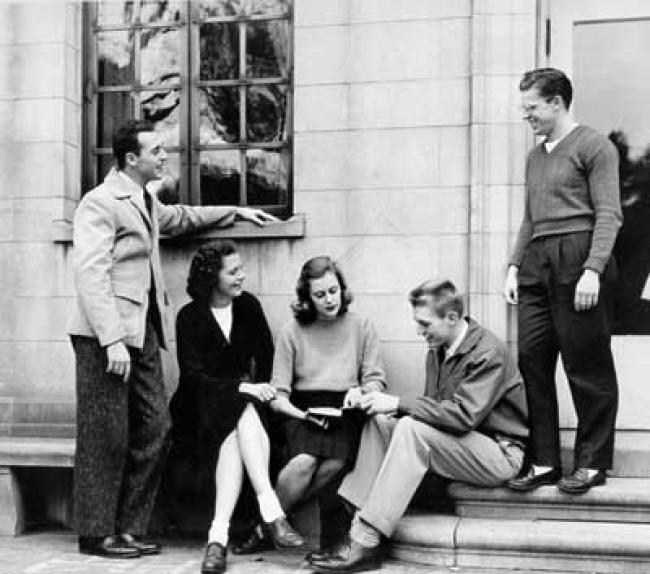GI Bill® students change Augustana outlook
(This story was written in celebration of Augustana's sesquicentennial in 2010.)
Wave of veterans brings a more worldly sensibility to campus
In the 1945-1946 school year, the student population of Augustana College and Theological Seminary nearly doubled: 773 students enrolled in the liberal arts college, in contrast with 430 the year before. In the 1946-1947 school year, the population nearly doubled again, reaching a total of 1,304 students enrolled in the liberal arts college.
The cause of these leaps in enrollment was, of course, the Serviceman's Readjustment Act of 1944, more commonly known as the "G.I. Bill." Among other benefits, the bill provided up to four years' tuition and books, plus a monthly stipend, for military veterans who wished to pursue an education upon returning to their civilian lives at the end of World War II.
Some who participated in the early stages of proposing the G. I. Bill had suggested limiting education benefits so that only the most qualified applicants received a full four years of paid schooling. The final bill, however, which was prepared by the American Legion, extended such benefits equally to all veterans.

Still, the offer of a free education proved vastly more popular than expected. Augustana President Conrad Bergendoff admitted this freely, writing in his 1946-1947 president's report that "no one, even in the Veterans' Administration, guessed the extent of the veteran enrollment."
Already in the previous year's report, Bergendoff had declared, "We are swamped by the number of returning vets." The college wrestled with questions of housing and admissions: where would the veterans live, and what would happen to the women on campus? Should admissions requirements be adjusted to accommodate the incoming veterans, or to ensure that enrollment did not exceed capacity?
Statistics in the college catalog show that, in the late 1940s through the early 1950s, a large percentage of enrolled Augustana students were veterans: in one year, nearly 50 percent of students attended under the G.I. Bill.
A lot more men
Because a vast majority of veterans were men, the male-to-female ratio increased as well, at one point reaching nearly two-to-one. Students who had begun at Augustana during the war celebrated this latter development as a welcome change and a sign of returning peace. Of the 1945-1946 freshman class, the Rockety-I rejoiced, "Believe it or not, the boys outnumber the girls. Normal times are here again."
World War II veterans who wished to attend college under the G.I. Bill were required to begin their schooling by 1951 in order to receive government funding. So, predictably, both enrollment and the male-to-female ratio decreased again in the early 1950s.
But the G.I. Bill ultimately had much more far-reaching implications for life at Augustana. For one thing, the newly enrolled veterans brought a unique and worldly sensibility to an admittedly insular campus. As former Augustana President Thomas Tredway writes in his college history, Coming of Age (2010), "The veterans had seen, done, and thought things that would never have been if they had entered college at 18, directly from high school."
Indeed, a number of veterans seem to have found the campus atmosphere somewhat stifling after their experiences in the military. The infamous Augustana "panty raid" of 1949 was conducted by a group of veterans, whose late-night antics in the Woman's Building (now Evald Hall) made a mockery of both the protective shield behind which the college placed its female students and the genteel standards to which it held the men.

But the veterans didn't just bring a broader range of experience to the Augustana campus: Their arrival meant greater ethnic diversity in the student body as well. The generous federal funding that the G.I. Bill offered led to a flood of new students seeking higher education, and Augustana joined institutions across the country in striving to accommodate those veterans. For a number of years after World War II, the college catalog contained a section that summarized veterans' benefits and detailed Augustana policies in connection with their education.
Not surprisingly, Augustana found itself inundated with applications from would-be students who were neither Swedish nor Lutheran. Tredway observes in Coming of Age that then-President Bergendoff, recognizing ongoing changes in the college and the country, sought to preserve Augustana's Lutheran-ness more so than its Swedish-ness.
Before and after World War II, Tredway writes, "The [college's] ties to Sweden became increasingly a matter of historical loyalty and respect for tradition rather than an ongoing determining factor in the growth and character of the school."
The increased ethnic diversity brought by the G.I. Bill contributed substantially to that trend. At the same time, the number of Lutherans on campus decreased: Tredway reports that 60% of Augustana students were Lutheran in the late 1930s, 50% in the late 1940s, and 40% in the late 1950s. But, committed to the college's Lutheranism, Bergendoff continued to strive for an Augustana where all facets of education were informed and enriched by religious faith.
Changes still seen today
In the early 21st century, Augustana defines itself explicitly as a liberal arts college, "committed," in the words of its mission statement, "to offering a challenging education that develops qualities of mind, spirit and body necessary for a rewarding life of leadership and service in a diverse and changing world."
Though it remains rooted in the Lutheran faith, Augustana enrolls students and employs faculty and staff from a wide variety of faiths. Though it acknowledges its Swedish heritage, its present population comes from a diverse ethnic background. In terms of sheer diversity, the influx of veterans nearly 60 years ago was a precursor to the Augustana our students know today.
— Stefanie Bluemle ‘02
Reference Librarian
GI Bill® is a registered trademark of the U.S. Department of Veterans Affairs (VA). More information about education benefits offered by VA is available at the official U.S. government Web site at https://www.benefits.va.gov/gibill.
